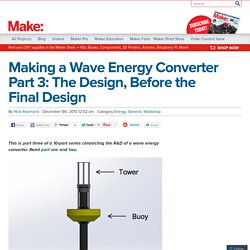

Permanent magnet DC Motor Water Turbine / Wind Generator Hand Generator 3000rpm. Nick Raymond. Making a Wave Energy Converter Part 3: The Design, Before the Final Design. This is part three of a 10-part series chronicling the R&D of a wave energy converter.

Read part one and two. Our team of five mechanical engineering students had set out to design a machine that could harness the up-and-down heaving motion of ocean waves and convert the kinetic energy into electricity. Since we were using this as our senior design project to earn credits towards graduation, we had to design and build a prototype within the 24-week timeframe of the class. After investigative research, the team had broken down the wave energy converter (WEC) into five major subsystems: buoy, hydraulics, electronics, spar, and heave plate.
Each subsystem had to perform a specific task governed by the requirements that we had set at the beginning of the project: 1. 2. 3. It’s easy to see that there are many ways to arrange five subsystems into a configuration that might generating electricity. Results from an early computer simulation to predict power output of WEC. Nick Raymond Related. Piezoelectric sensor. A piezoelectric disk generates a voltage when deformed (change in shape is greatly exaggerated) Applications[edit] Piezoelectric disk used as a guitar pickup Piezoelectric sensors have proven to be versatile tools for the measurement of various processes.

They are used for quality assurance, process control and for research and development in many industries. Although the piezoelectric effect was discovered by Pierre Curie in 1880, it was only in the 1950s that the piezoelectric effect started to be used for industrial sensing applications. One disadvantage of piezoelectric sensors is that they cannot be used for truly static measurements. However, it is not true that piezoelectric sensors can only be used for very fast processes or at ambient conditions. Piezoelectric sensors can also be used to determine aromas in the air by simultaneously measuring resonance and capacitance.
Piezoelectric sensors are also seen in nature. Principle of operation[edit] Transverse effect[edit] apply, where. Mini Generators Use Vibrations from Traffic, Human Movement to Create Electricity. Talk about good vibrations.

Researchers at the University of Michigan are developing tiny generators that harvest the kinetic energy going on around us on a daily basis. The Parametric Frequency Increased Generators, or PFIGs, scavenge tiny vibrations created by traffic on streets or bridges, people walking up and down stairs or even machinery operating in factories. The teensy power providers could eventually provide electricity for devices like watches, pacemakers and wireless sensors that monitor infrastructure. So far scientists designed three prototype PFIGs with a fourth on the way. The first two utilize electromagnetic induction to convert energy, much like large-scale generators at power plants do. Designers say the PFIGs could be used to power small devices like wrist watches, pacemakers and wireless sensors that could have huge implications for infrastructure health monitoring. . + University of Michigan Via ScienceDaily. 15 cellphone chargers that harness kinetic energy for a clean recharge.
Human body is often blamed to be an inefficient, energy-wasting machine.

However, if we consider “energy harvesting” from the human body itself and harness the kinetic aspect of it, it might help us reducing our reliance on alternative resources of energy, like solar power, wind power, etc. Here is a list showing certain innovative and out of the box mechanical devices for generating electricity for your gadgets like cellphones and parallel devices. • Foot-powered cell phone charger: Developers: Orange and Gotwind. The device harnesses kinetic energy from an airbed foot pump that drives an embedded turbine. . • Mechanical Mobile: Designer: Mikhail Stawsky.
The Mechanical Mobile generates ample energy to power itself when you spin it around your finger or crank the tip. . • Yo-Yo mobile phone charger: Designer: Emmanuel Hansen. The hand-held mobile phone charger concept harnesses the kinetic energy generated through playing a yoyo. . • iYo induction charger: Designer: Peter Thuvander. • Watts Maker: